Wedding Customs
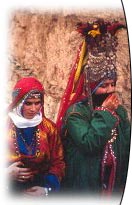 Marriage, another turning points of the life, is both individual since it brings together the lives of a man and a woman, and social, since it establishes family and kinship ties. The wedding ceremony takes place as a “festival”, especially in small village communities, since it is an activity covering the whole village. While some of the ceremonies held during different stages of the wedding can be considered as a feast and entertainment, others resemble an “elegy”.
Marriage, another turning points of the life, is both individual since it brings together the lives of a man and a woman, and social, since it establishes family and kinship ties. The wedding ceremony takes place as a “festival”, especially in small village communities, since it is an activity covering the whole village. While some of the ceremonies held during different stages of the wedding can be considered as a feast and entertainment, others resemble an “elegy”.
The stages of customs and ceremonies covering the whole wedding procedure can be listed as following:
A. Before the wedding
I. Matchmaking and asking for the hand of a daughter
II. a. Verbal agreement to betrothal
b. Sherbet
c. Engagement
III. Koran-accompanied wedding gift announcement
IV. Sending and exhibiting the trousseau
V. Bridal bath
B. Wedding
I. Henna night
a. Bride henna
b. Groom henna
II. Receiving the bride
III. Marriage
IV. Bridal Chamber
V. After the Bridal Chamber
C. Practices after the wedding
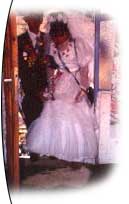 After the decision that a young man is to marry has been taken, the journey begins with looking for a potential bride. In traditional parts of society in particular, families which wanted to marry off a son used to take a leading role in the search for a bride. It may be observed that this situation has started to change recently. Young people themselves choose the people whom they will marry after dating them, or the decision is taken together with the family.
After the decision that a young man is to marry has been taken, the journey begins with looking for a potential bride. In traditional parts of society in particular, families which wanted to marry off a son used to take a leading role in the search for a bride. It may be observed that this situation has started to change recently. Young people themselves choose the people whom they will marry after dating them, or the decision is taken together with the family.
In the form of marriage that is initiated by “viewing visits”, the mother of the boy and women close to the family visit the home of the girl and inspect her. If they like the girl, she is then shown to the groom. If he also likes her, the family decides to officially ask her family for her hand.
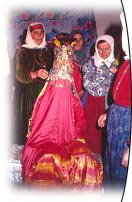
Visiting the home of the girl and asking her father for her hand is called “dünürlük” (task of father and mother-in-law), “dünürlüğe gitme” (visiting as father and mother-in-law), and “elçiliğe gitme” (visiting as an envoy) and similar names. The prominent women and men from the family visit the girl’s family to ask for her hand according to the command of God and the word of the Prophet at a previously determined sacred date (Thursdays and Sundays are generally considered days of good omen). Yet since the girl’s home is expected to be a place of modesty, the girl’s family does not give its consent on the first visit. A few visits to ask for the girl’s hand are made, giving the family of the girl enough time to think about it. If the family gives its consent, a verbal agreement to betrothal is made. In accordance with the request of the two sides, the bride and groom may put on their engagement rings on the same day, and this is sometimes done at an engagement ceremony held separately. After verbal agreement to betrothal has been made, the guests and the hosts drink sherbet to provide a sweet harmony between the families, which is a widespread custom. Drinking sherbet means that the family of the girl consents to the marriage and that it will go ahead. The families also discuss issues such as the dates of the engagement and wedding ceremonies, the household goods to be purchased or the amount of bride price as they make their verbal agreement to the betrothal.
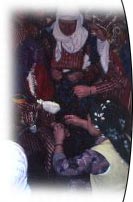 After both sides have completed their preparations, an engagement ceremony is held at the girl’s home, generally with the women in attendance. The man’s family hands over the jewelry and other gifts purchased for the girl; in return, her family also gives presents. The ceremony can include an engagement feast if the sides so wish. This joyous event is at the same time celebrated with entertainments. Engagement means both take a step towards to the marriage and starting period determined for the wedding and an opportunity for the both sides to get to know each other and maintain a harmonious relationship. In the event of disagreement between the sides, the engagement can be broken down, although this is almost always a last resort.
After both sides have completed their preparations, an engagement ceremony is held at the girl’s home, generally with the women in attendance. The man’s family hands over the jewelry and other gifts purchased for the girl; in return, her family also gives presents. The ceremony can include an engagement feast if the sides so wish. This joyous event is at the same time celebrated with entertainments. Engagement means both take a step towards to the marriage and starting period determined for the wedding and an opportunity for the both sides to get to know each other and maintain a harmonious relationship. In the event of disagreement between the sides, the engagement can be broken down, although this is almost always a last resort.
The next stage after the engagement is the wedding. First of all, the people around should be invited to the wedding. Another custom that is fading nowadays is distributing “recited” food or gifts to the people in the village. (The Koran is recited as the gifts or food to be distributed are prepared, hence the name.) In one sense, a wedding invitation can even be “recited”. One individual is charged with distributing the ‘recited’ gifts to the village. These can be a piece of cloth, a handkerchief, a hand-painted kerchief, or food such as sugar and pastries. As these are distributed the guests are also invited to the wedding.
Although fairy tales mention wedding ceremonies lasting forty days and forty nights, they generally last for three days in Anatolia. Currently, two-day ceremonies held on the weekends are preferred for economic and social purpose.
The wedding ceremony, the basis of marriage, consists of two main parts:
a. Henna night
b. Receiving the bride
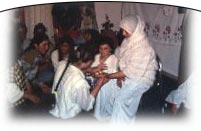 The ceremony held one day before the wedding in the home of bride and groom is called the henna night. It generally takes place at the girl’s home and among the women, although either side can elect to host it.
The ceremony held one day before the wedding in the home of bride and groom is called the henna night. It generally takes place at the girl’s home and among the women, although either side can elect to host it.
A flag is planted on the roof of the man’s home at an early hour on the day henna night will be held. This is done by a specially chosen standard-bearer in the company of a large crowd, who celebrate the occasion amid great festivities. In some places, a meal called flag bread is handed out to the crowd. Flag-planting means the wedding has officially started.
On the day of henna night is to be held, or a few days earlier, the trousseau is taken from the girl’s home and brought to the man’s, and the bridal chamber is prepared. The trousseau is sometimes exhibited to the guests for a few days in the girl’s home before the wedding, and in the man’s home during and after it. It is a widespread tradition that someone sits on the trousseau chest, asking for a tip as it is taken from the girl’s home. In addition, in the early hours of the day the henna night is to be held, a group of women from the bridegroom’s family take the henna that will be placed on the bride’s hands and feet, her clothes and the food that will be offered to the guests to the girl’s home, again to the accompaniment of great festivities. The women who gather in the girl’s home on the henna night have fun for a while, but later try to make her cry by singing sad songs. Henna that has earlier kneaded with water is brought in on a tray surrounded by candles and placed in the middle of the room. In some places, the henna is first put on the hands of the bride and then distributed to the guests; the other areas the henna is first distributed to the guests, and only after everybody has left it is placed on the bride’s hands. If the woman so wishes, henna can also be placed on her feet apply to the hair. Considerable attention is paid to charging a woman with a happy marriage, called the “başı bütün” (meaning “whose head is complete”, In a sense, this describes her as someone who has a complete family with husband and children and whose marriage is whole, not separated by divorce) to knead and distribute the henna and apply it to the girl’s hand. The woman places the henna on one of the bride’s hands, and a young girl places it on the other. Before the henna is applied, coins or gold are also placed in her hands.
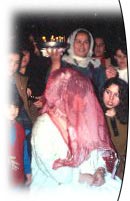 The day after the henna night is the day for receiving the bride and of the main wedding ceremony. Both sides to the wedding offer food to the guests, usually entertaining them to the accompaniment of drums and reeds. In the early hours of the morning, ceremonies known as the bridegroom shave, preparing the bridegroom and such are held at the man’s home. The bride is readied in her own parent’s home. Professional women who work at all wedding ceremonies and prepare the wedding feasts are generally employed for this. On that day, the guests in the man’s home go to the girl’s house to receive the bride. As the bride leaves her father’s home, a red belt, also called a belt of perseverance, is tied around her waist by her brother or uncle. After the bride has said farewell to her family, she is taken out of her father’s home to the accompaniment of prayers, sometimes to hymns, and sometimes with festivities accompanied by reed and drum. As the bride leaves her home, she does things at home so that her single friends may also marry. These include unraveling an unfinished stocking before she leaves so that her friends can marry one after the other in rapid succession, like the unraveled stocking. Some religious and magical rites are performed to provide the couple with happiness, for a smooth marriage as the bride is leaving her father’s home and as she steps into the man’s home. These include a mirror being held behind the bride as she leaves her father’s home, expressing the wish for her to have a bright life. In the same way, as she is passing through the threshold of the man’s home, butter, honey and similar things are spread on the threshold and the door jamb with the aim of providing a sweet harmony between the bride and the people in her new home.
The day after the henna night is the day for receiving the bride and of the main wedding ceremony. Both sides to the wedding offer food to the guests, usually entertaining them to the accompaniment of drums and reeds. In the early hours of the morning, ceremonies known as the bridegroom shave, preparing the bridegroom and such are held at the man’s home. The bride is readied in her own parent’s home. Professional women who work at all wedding ceremonies and prepare the wedding feasts are generally employed for this. On that day, the guests in the man’s home go to the girl’s house to receive the bride. As the bride leaves her father’s home, a red belt, also called a belt of perseverance, is tied around her waist by her brother or uncle. After the bride has said farewell to her family, she is taken out of her father’s home to the accompaniment of prayers, sometimes to hymns, and sometimes with festivities accompanied by reed and drum. As the bride leaves her home, she does things at home so that her single friends may also marry. These include unraveling an unfinished stocking before she leaves so that her friends can marry one after the other in rapid succession, like the unraveled stocking. Some religious and magical rites are performed to provide the couple with happiness, for a smooth marriage as the bride is leaving her father’s home and as she steps into the man’s home. These include a mirror being held behind the bride as she leaves her father’s home, expressing the wish for her to have a bright life. In the same way, as she is passing through the threshold of the man’s home, butter, honey and similar things are spread on the threshold and the door jamb with the aim of providing a sweet harmony between the bride and the people in her new home.
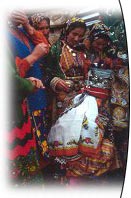
People throw out the sweets, coins, dried fruits and nuts over the head of the bride, as an expression of a wish for abundance.
The night of the wedding, a small feast is given to the remaining few guests in the house of the groom’s family, and then a religious ceremony is held to marry the couple, presided over by the imam. In earlier times, the official wedding could be held any time after the ceremony; but recently, great care has been taken that the official wedding should be held before the wedding ceremony. The official wedding is usually held when the families of the bride and groom come together to go shopping for the ceremony.
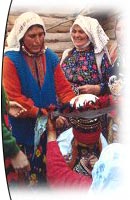 After the religious ceremony, the couple come together in their own room. Meanwhile, a series of religious rites and spells are performed to provide a harmonious relationship between bride and groom. These include thrusting a knife into the door of the room, or opening a lock in front of the door. In addition, the people there are asked not to cross their hands and arms. Food specially prepared earlier for that night by the bride and placed in her trousseau chest, together with a food tray with other meals, are left in the room. In some places, a single spoon, a single fork and a single glass are put on the tray to oblige the bride and groom to share them. It is believed that they will get used to each other much quicker that way. Then follows the custom of inspecting the bed sheet that is the symbol of the bride’s innocence and chastity. The aunt or cook who is responsible for organizing the wedding is informed of the situation of the bride, and then conveys this news back to the families. Sometimes, if the bride proves not to be a virgin, she may be sent back to her father’s home.
After the religious ceremony, the couple come together in their own room. Meanwhile, a series of religious rites and spells are performed to provide a harmonious relationship between bride and groom. These include thrusting a knife into the door of the room, or opening a lock in front of the door. In addition, the people there are asked not to cross their hands and arms. Food specially prepared earlier for that night by the bride and placed in her trousseau chest, together with a food tray with other meals, are left in the room. In some places, a single spoon, a single fork and a single glass are put on the tray to oblige the bride and groom to share them. It is believed that they will get used to each other much quicker that way. Then follows the custom of inspecting the bed sheet that is the symbol of the bride’s innocence and chastity. The aunt or cook who is responsible for organizing the wedding is informed of the situation of the bride, and then conveys this news back to the families. Sometimes, if the bride proves not to be a virgin, she may be sent back to her father’s home.
The day after the wedding, other festivities called the bridal veil day, face revealing or head covering are held. These are much simpler than what has gone before and involve only the women. In earlier times, the bride would be taken to the village fountain and asked to fetch water during these festivities. The bride also used to knead dough and cook pastry. This was the result of a belief that such things would bring abundance to the new home. These things have all been forgotten, however. Bridal veil day festivities are not held in many places either any more.